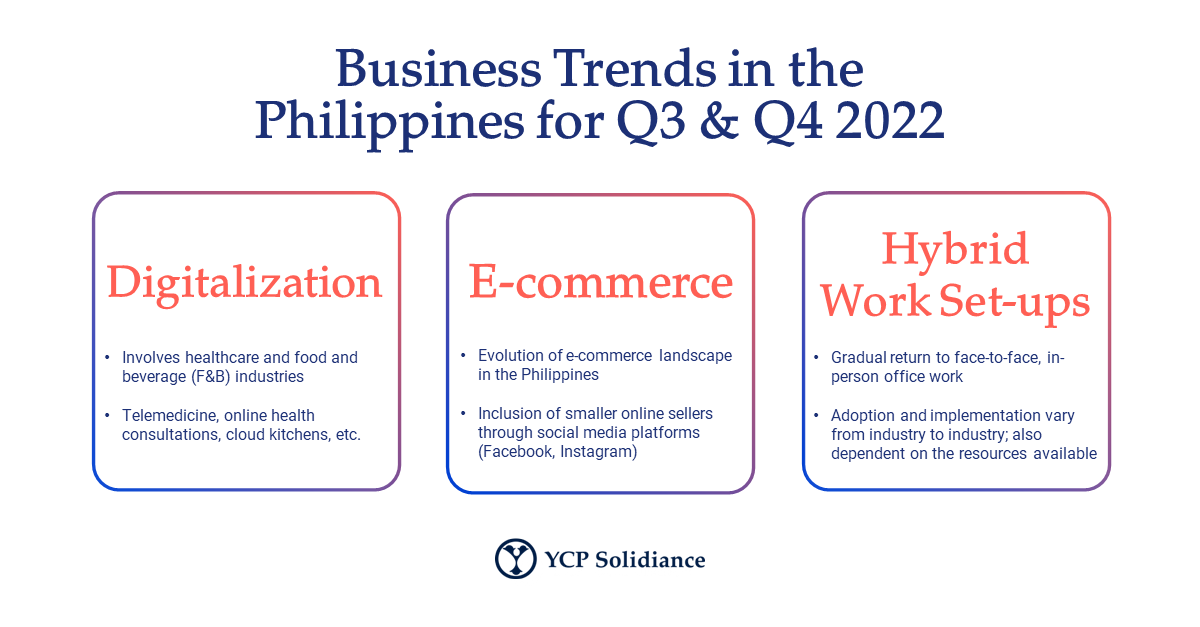What should businesses and professionals in the Philippines expect in the second half of 2022? As part of a new series, YCP Solidiance will be releasing several in-depth articles that revisit previously analyzed emerging business trends in the Philippines, guided by research and analysis from our team of professionals in the country.
Read the first installment below to get a better understanding of the emerging business trends in the Philippines for the second half of 2022 and early 2023. To read future installments of this series, subscribe to our newsletter here.

Trend 1: Digitalization of Industries
Largely due to the COVID-19 pandemic and its adverse effects, Philippine businesses have invested heavily in digitalization. Aside from addressing difficulties such as labor shortages and decreased mobility, the digitalization of businesses in the Philippines has also offered advantages such as wider accessibility and maximized efficiency.
Of the professional sectors in the Philippines undergoing digitalization, the healthcare and food industries are expected to trend in the second half of 2022 and early 2023. For the healthcare sector, the Philippines has followed its Southeast Asian neighbors like Indonesia and Malaysia wherein telemedicine or digital medical consulting has been gradually adopted.
Meanwhile, local businesses in the food industry are building on previous digitalization successes like online delivery by exploring the use of cloud kitchens—a concept wherein pre-existing, fully equipped kitchens can be tapped by online food and beverage brands to fulfill a variety of services such as product fulfillment, end-to-end management, rental space, etc.
Trend 2: E-commerce Growth
Businesses in the Philippines have used the country’s increased social media and internet penetration rates as a launch point to gain traction in other digital spaces. One such industry that has benefitted heavily from the digital capability of the Philippines and its citizens is the e-commerce sector.
Compared to 2021, the e-commerce landscape in the Philippines has been far more inclusive and accessible to smaller players thus far due to the emergence of platforms like Facebook Marketplace and Instagram for Business accounts. While conglomerates like Lazada and Shopee will remain an important part of the Philippine e-commerce ecosystem in Q3 and Q4 of 2022, interested parties should expect e-commerce players to flourish beyond these platforms.
Trend 3: Hybrid Work Setups
At the onset of the pandemic, many businesses in the Philippines adopted remote, work-from-home (WFH) setups to account for the lack of mobility of their employees. Given that business conditions are gradually normalizing within the country, companies are now moving toward hybrid and back-to-office work setups.
In the context of this shift, the implementation of hybrid work setups will differ from industry to industry. For instance, those in the Philippine business process outsourcing (BPO) industry have employed 70% onsite, and 30% remote work set-ups. Further, considering that many BPOs operate in Philippine Economic Zone Authority (PEZA) locations, companies will still be able to avail of favorable tax incentives through a hybrid arrangement.
Private companies like auditing firms and fast-moving consumer goods (FMCG) companies are also slowly transitioning to hybrid setups this 2022, but with additional preventive measures such as regular testing and contact tracing. Meanwhile, other companies with additional resources are also experimenting with hybrid work setups by investing in facilities like private gyms, rest nooks, and individual call booths, which serve to incentivize employees via a balanced work-play approach.






